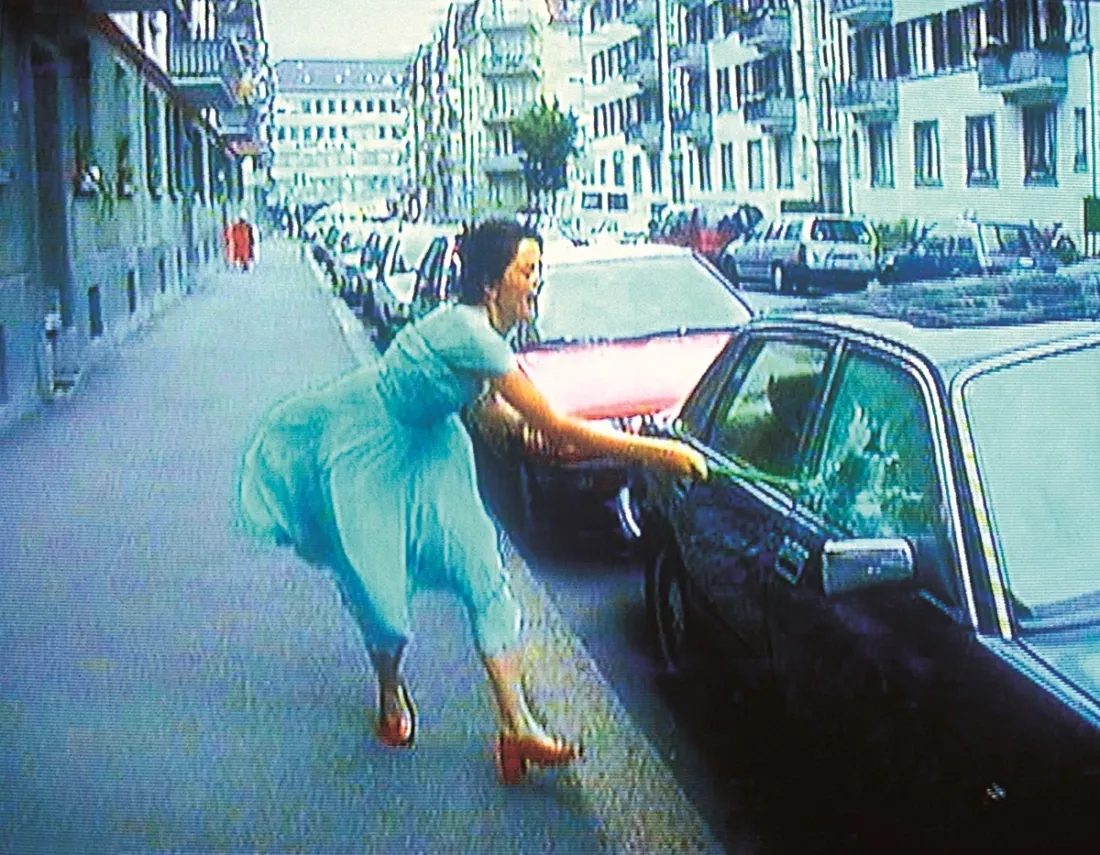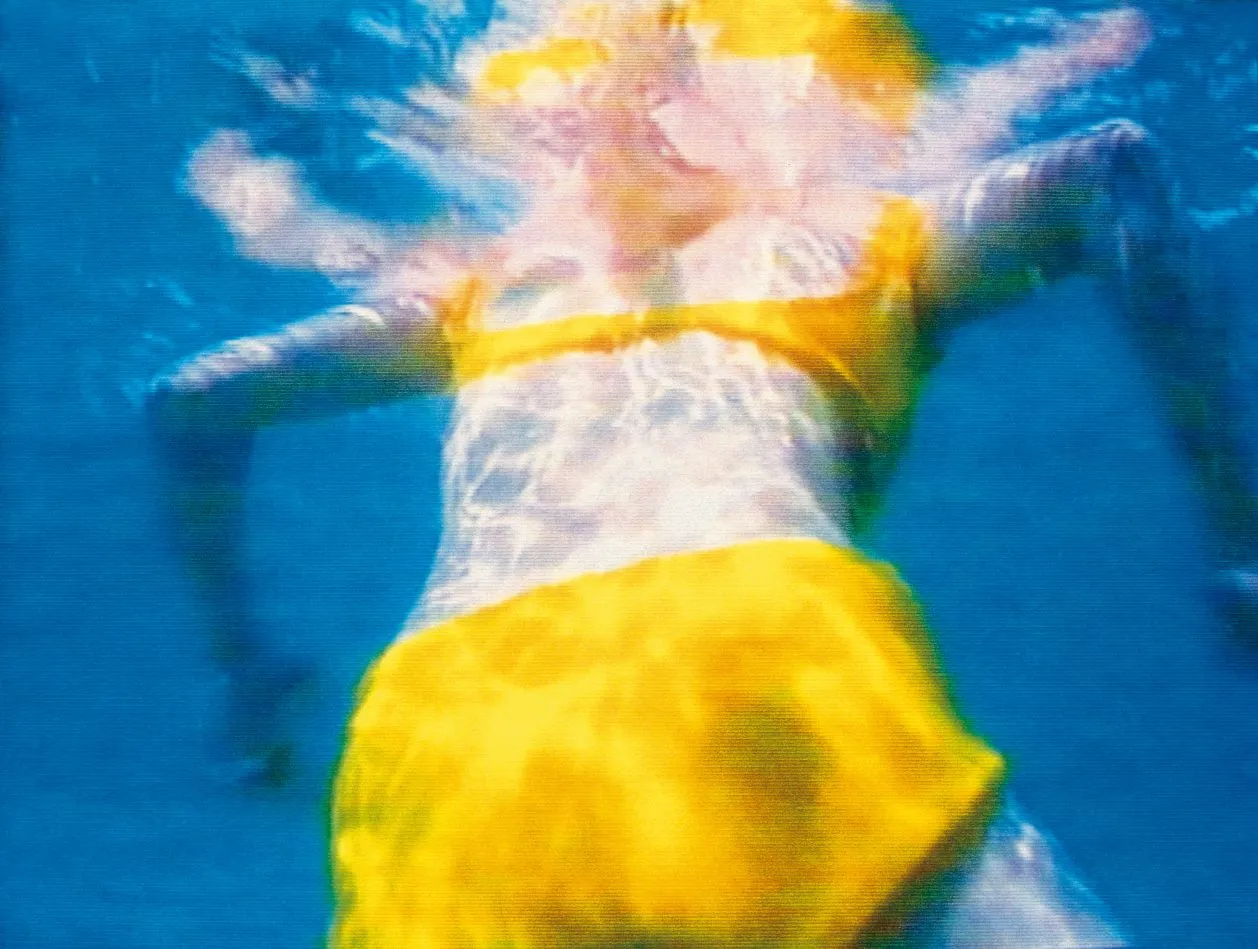 Pipilotti Rist, Ever Is Over All, 1997. Two channel audio-video installation (video still). Courtesy the artist, Hauser & Wirth and Luhring Augustine
Pipilotti Rist, Ever Is Over All, 1997. Two channel audio-video installation (video still). Courtesy the artist, Hauser & Wirth and Luhring Augustine Throughout art history, few artists and fewer artworks have adopted a minimalistic aesthetic while retaining an emotionally charged quality, such as Pipilotti Rist's Ever Is Over All (1997). In technical terms, the artwork is a video work and the first in which the Swiss artist extends the image beyond the square framework of a TV screen onto a large-scale installation overtaking the architecture. On the other hand, Rist materializes inner anger into a visual narrative sequence, transfiguring the protagonist's seemingly aggressive, destructive act into a gesture of liberation.
Since the film was first showcased at the 47th Venice Biennale, where it won the Premio 2000 award for emerging talents, Ever Is Over All has continued to captivate audiences, forcing experts to dissect the piece in search of the triggering elements in its spectacular composition. In this regard, Rist's work is similar to a harmonious symphony, in which it isn't easy to decipher singular elements that compose the whole. Only in a cacophony does the dissonance become instantly evident and easily defined.
Some find the pure joy of the female figure while smashing car windows cathartic, while others are more drawn to the painterly quality of the color noise or the immersiveness of the audio-visual installation and its lulled humming sound spellbinding. Or perhaps it is the precise combination of such elements fusing culture and technology that evokes emotion, able to find multiple sensational pathways. Therein lies the secret of Pipilotti Rist's masterful moving images, which she once likened to women's handbags, with "room in them for everything: painting, technology, music, lousy flowing pictures, poetry, commotion, premonitions of death, sex, and friendliness."

Pipilotti Rist explained in an interview once that her creative process differs for each artwork, underscoring that "some are survival tactics, some are psychotic tics, some are very well thought over." In the case of the video work Ever Is Over All, the point of departure was an utterly personal occurrence, an entirely intimate thought, and what the artist described as "a very weak moment." When an Editor-in-Chief of a newspaper invited Rist to be the guest editor for an issue, he initially gave her carte blanche but disagreed with her choice for the magazine cover.
Rist wanted a picture of an old lady on the cover, but the editor told her to change it, citing low sales projections as the only reason. At that moment, as the groundbreaking video artist recalled, a mental image of her smashing his car popped up as a highly instinctive reaction to his duplicitous behavior. That picture became the nucleus for Ever Is Over All as a way to transform personal anger into something productive and redirect it into something creative but also explore the fibers of the inherent and universal feeling.

The final work comprises two slow-motion projections always displayed on adjacent walls, almost bringing them closer for the viewer. In one of them, we see the narrative of the female protagonist dressed in a flowy blue dress and red shoes, strolling gleefully along the street. The scene is juxtaposed with a luscious field of blooming flowers, seeping and partly overlapping with the first video. The dreamlike effect of the scene is abruptly cut when Silvana Ceschi (the filmmaker who plays the protagonist) starts smashing the side windows of several cars lining the streets with the flower she has in her hand.
That elegant minimalistic twist of how a delicate flower, a symbol of beauty, transforms into a destructive instrument in the hands of the woman, whose dress amplifies femininity, reconfigures the norm, pushing many to read the piece as a feminist statement of empowerment. Further, Rist turned the destructive act upside down by eliminating anger and presenting the smashing as a norm, or at least an act that wouldn't make anyone's head turn on the street. A woman and a boy pass her by without noticing, and a female police officer offers her a nod and a smile as signs of approval.
After debuting in Venice, all three editions of Rist's Ever Is Over All were acquired by leading institutions across the world, including the Museum of Modern Art New York, the Museum of Contemporary Art Chicago, and the National Museum of Modern Art in Kyoto.

As an installation occupying space overflowing irregularly onto the walls, it relies to a great measure on its monumentality. The video itself is in slow motion, but as Rist once explained, dimension plays a major part in how we perceive the action portrayed, and as the image gets bigger, so does the impression that things are happening faster than they are in reality.
Choosing the cars as victims, Rist questioned how quickly humanity adapted to the technological invention, adopting it as a norm or "as a given," to which she administered "a counterforce." The video itself was taken with four small consumer-grade cameras, where the standard definition gains a painterly quality by color noise and hues seeping into one another. The vibrancy of Rist's works is particularly well exemplified in Ever Is Over All, but to all those who label her work as "colorful," the ingenious artist once responded, "I'm not more colorful than life is."
However, color has an essential place in Rist's aesthetic, employing the subversive capacities of color, which is perceived as dangerous, unpredictable, eyecatching, and seductive in Western discourse. Inspired by David Batchelor's book Chromaphobia, Pipilotti Rist delves deep into this fear of color, harnessing its emotional and psychological properties. Klaus Biesenbach, a former director of MoMa PS1, condensed the artist's revolutionary approach to color treatment when referring to Rist's Sip My Ocean, which functions as a precursor for Ever Is Over All, expressing that it changed his curatorial practice by offering a new view on color:
I looked at videos differently after seeing it, and I looked at color differently.
Yet, it seems that the open-ended nature of the work captivates the viewers the most. Rist offers no definitive explanation about the protagonist's act, leaving us to fill in the blanks, essentially engaging the audience. The universality of the thought and an act of presumably inner anger materialized in the narrative is the secret of its appeal, addressing an inherently primal, emotional, and shared human nature.
